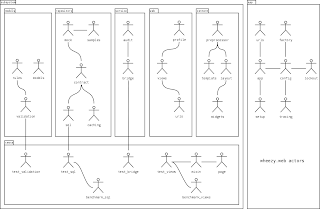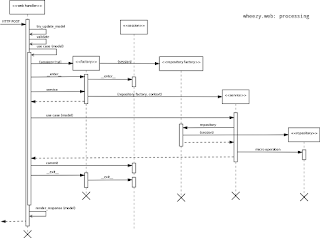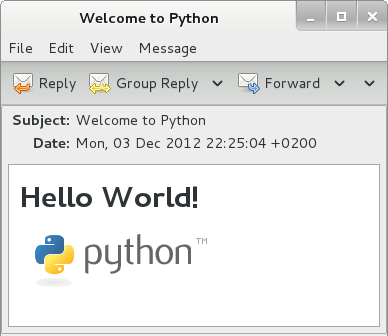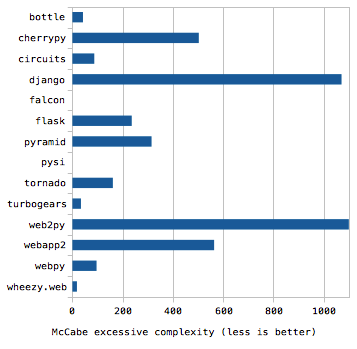All libraries related wheezy.web and wheezy.template have been recently migrated from bitbucket to github.
Showing posts with label python. Show all posts
Showing posts with label python. Show all posts
Saturday, August 29, 2020
Saturday, August 1, 2020
Python ASGI CLI
Call ASGI Python application module from command line (without an application server), just like CURL. Interested?
Wednesday, May 27, 2015
Asynchronous Python in Web Applications
Asynchronous or non-blocking IO allows worker to process other requests before current request has finished. That is possible in case a processing of current web request is related to an operation that is IO bound.
Prerequisites
What is important to understand about applicability of async pattern for IO bound operations, they must:- Utilize the same event loop, in this case worker's event loop can switch to next in the queue (otherwise it is blocked).
- Have long latency (otherwise you are wasting event loop queue for short requests).
Labels:
python
,
wheezy.web
Saturday, April 4, 2015
wheezy template: static website generator
Sometimes you need a quick way to generate a static web site and put it up on a server. Here is how you can generate a static website with wheezy.template.
Let's suppose the following structure of the site:
content/
`- index.html
- main.html
shared/
`- master.html
snippet/
`- script.html
- widget.html
Labels:
python
,
wheezy.template
Wednesday, October 29, 2014
wheezy web: RESTful API Design
In this article we are going to explore a simple RESTful API created with wheezy.web framework. The demo implements a CRUD for tasks. Includes entity validation, content caching with dependencies and functional test cases. The source code is structured with well defined actors (you can read more about it here).
Design
The following convention is used with respect to operation, HTTP method (verb) and URL:List: GET /api/v1/tasks
Add: POST /api/v1/tasks
Get: GET /api/v1/task/{task_id}
Update: PUT /api/v1/task/{task_id}
Remove: DELETE /api/v1/task/{task_id}
The task entity consists of the following attributes: task_id, title and status. The source code is available here. Please download before proceeding any further.
Labels:
python
,
wheezy.web
Monday, August 4, 2014
wheezy web: deploy nginx + uwsgi + memcached
wheezy.web is a lightweight, high performance, high concurrency WSGI web framework with the key features to build modern, efficient web. Here we will deploy quick start with nginx, uwsgi and memcached to clean debian stable installation.
Thursday, November 14, 2013
How to build Python deb package from source
You need a newer python version that is not available with the Debian package management system. You can compile it from source and install but that usually takes a lot of time. It would be better to build a deb instead and install it on as many machines as you need. You can use checkinstall for this.
apt-get install checkinstallThe instruction how to compile python from source is here. Once you compiled python here is a simple command that does the rest for you:
checkinstall -y --pkgname=python2.7Once it finishes you will get a deb file in the current directory. You can install it this way:
dpkg -i python2.7_2.7.6-1_i386.debHere is how to remove it:
apt-get remove --purge python2.7Note, packages built with checkinstall are not updated by OS package management system, thus updates need to be provided manually.
Sunday, October 13, 2013
Python HTTP Client API
The modern web services expose public API to the world and JSON is de-facto standard in this communication. Here is a simple use case that integrates with buildbot public API.
Lets setup a virtual environment and install wheezy.core package:
Lets setup a virtual environment and install wheezy.core package:
virtualenv env env/bin/easy_install wheezy.coreLaunch python from virtual environment (env/bin/python) and try this:
>>> from wheezy.core.httpclient import HTTPClient
>>> c = HTTPClient('http://buildbot.buildbot.net/json/')
>>> c.get('project')
200
>>> project = c.json
>>>> str(project.title)
Buildbot
Here is another example that demonstarates etag handling (the second time we request events the server responds with HTTP status code 304, not modified):
>>> base = 'https://api.github.com/repos/python/cpython/'
>>> c = HTTPClient(base)
>>> c.get('events')
200
>>> c.headers['content-encoding']
['gzip']
>>> c.get('events')
304
The HTTPClient supports HTTP(S) GET/HEAD/POST verbs, follows redirects, handles cookies and etags between requests, gzip content decoding.
Labels:
algorithms
,
python
,
wheezy.core
Wednesday, October 2, 2013
How to manage Git or Mercurial repositories
Managing version control repositories can be a challenge in multi-user environment especially when simplification of user collaboration is your goal. There are usually two primary concerns while considering enterprise deployment for version control repositories: access control and safety of your data. Both are not directly addressed by version control itself, thus a sort of security facade is necessary.
Tuesday, September 10, 2013
wheezy web: Actors
The application design of wheezy.web application consists of several actors, each playing its unifying role. Actors are grouped into packages, e.g. models, repository, service, web, content, tests, etc. These packages (or layers) shape a subsystem.
The diagram below visualizes relations between actors, boundaries between packages, subsystems and application, giving a better picture of whole: The sequence diagram explains request processing and interaction between actors: You can download a pdf copy here.
The diagram below visualizes relations between actors, boundaries between packages, subsystems and application, giving a better picture of whole: The sequence diagram explains request processing and interaction between actors: You can download a pdf copy here.
Labels:
python
,
wheezy.web
Wednesday, February 6, 2013
Thoughts on SQL vs ORM
The question of persistence implementation arise often. I found repository pattern very valuable due to separation of concerns, mediate between domain model and data source (mock, file, database, web service, etc). The database data source is somewhat specific since you can proceed with SQL functions or ORM. Here are some thoughts why you might prefer SQL functions over ORM in your next project:
Labels:
python
,
wheezy.core
,
wheezy.web
Wednesday, January 16, 2013
wheezy web: Quick Start i18n Project
wheezy.web is a lightweight, high performance, high concurrency WSGI web framework with the key features to build modern, efficient web. Here we will use an i18n (multilingual internationalization) project quick start to build a new project.
- Download quickstart-i18n.zip and extract.
- Rename extracted directory `quickstart-i18n` to meet your project name, e.g. mysite and open terminal in that directory.
make envInternationalization is built using gettext, thus you need extract gettext messages and compile `*.po` files that you can find in i18n directory.
make poLet run test, look at coverage and finally benchmark tests:
$ make test nose-cover benchmark .................................... .......... Name Stmts Miss Cover Missing -------------------------------------------------- public 3 0 100% public.web 0 0 100% public.web.profile 5 0 100% public.web.urls 10 0 100% public.web.views 26 0 100% -------------------------------------------------- TOTAL 44 0 100% ----------------------------------------------------- Ran 10 tests in 0.458s OK public: 5 x 1000 baseline throughput change target 100.0% 5303rps +0.0% test_root 94.4% 5005rps -5.6% test_home 98.2% 5206rps -1.8% test_error_400 99.2% 5258rps -0.8% test_error_403 97.9% 5191rps -2.1% test_error_404 static: 3 x 1000 baseline throughput change target 100.0% 5172rps +0.0% test_static_files 47.4% 2453rps -52.6% test_static_file_not_found 52.5% 2715rps -47.5% test_static_file_forbidden ----------------------------------------------------- Ran 2 tests in 2.286s OKThe tests are passed let run it in web browser:
$ make run Visit http://localhost:8080/Alternatively you can run it using uwsgi
env/bin/easy_install uwsgi make uwsgiEnjoy!
Labels:
python
,
wheezy.web
Tuesday, January 15, 2013
wheezy web: Quick Start Empty Project
wheezy.web is a lightweight, high performance, high concurrency WSGI web framework with the key features to build modern, efficient web. Here we will use an empty project quick start to build a new project.
- Download quickstart-empty.zip and extract.
- Rename extracted directory `quickstart-empty` to meet your project name, e.g. mysite and open terminal in that directory.
make envLet run test, look at coverage and finally benchmark tests:
$ make test nose-cover benchmark .................................... .......... Name Stmts Miss Cover Missing -------------------------------------------------- public 3 0 100% public.web 0 0 100% public.web.profile 5 0 100% public.web.urls 10 0 100% public.web.views 20 0 100% -------------------------------------------------- TOTAL 38 0 100% -------------------------------------------------- Ran 10 tests in 0.423s OK public: 5 x 1000 baseline throughput change target 100.0% 5041rps +0.0% test_root 81.3% 4097rps -18.7% test_home 99.4% 5008rps -0.6% test_error_400 100.3% 5055rps +0.3% test_error_403 98.7% 4975rps -1.3% test_error_404 static: 3 x 1000 baseline throughput change target 100.0% 4846rps +0.0% test_static_files 49.8% 2415rps -50.2% test_static_file_not_found 55.0% 2663rps -45.0% test_static_file_forbidden ----------------------------------------------------- Ran 2 tests in 2.375s OKThe tests are passed let run it in web browser:
$ make run Visit http://localhost:8080/Alternatively you can run it using uwsgi
env/bin/easy_install uwsgi make uwsgiEnjoy!
Labels:
python
,
wheezy.web
Monday, December 3, 2012
How to Send Mail in Python
There are several use cases how you can send an email message using Python:
- Plain Mail: an email message with plain text or html content.
- Mail with Attachment: an email message with attached document.
- Alternative Mail Views: you provide a convenient way to email recipients to view your message in plain text or html with optional rich content including images, etc.
Labels:
algorithms
,
python
,
wheezy.core
Wednesday, November 28, 2012
How to ship eggs with pyo files only in Python
There is sometimes a need to ship python egg distribution with pyo files only. There is confusion using bdist_egg command since it doesn't have any options to do that; instead, you can instruct install_lib command. Here is what you need in setup.cfg file:
[install_lib] compile = 0 optimize = 2 [bdist_egg] exclude-source-files = 1Issue the following command to build egg.
python setup.py -q bdist_eggNote, the egg file has only python byte code optimized module files (look at dist directory). You can read about compiled modules here.
Labels:
python
,
setuptools
,
tricks
Tuesday, November 20, 2012
Python Web Frameworks Excessive Complexity
Cyclomatic (or conditional) complexity is a metric used to indicate the complexity of a source code. In this post we will take a look at web frameworks source code and estimate excessive complexity, something that is beyond recommended level of 10 (threshold that points to the fact the source code is too complex and refactoring is suggested). Here is a list of web frameworks examined:
- bottle
- cherrypy
- circuits
- django
- falcon
- flask
- pyramid
- pysi
- tornado
- turbogears
- web.py
- web2py
- webapp2
- wheezy.web
hg clone https://bitbucket.org/akorn/helloworld cd helloworld/04-pep8 && make env upThe make file has a target for mccabe metric, so issue make mccabe.
Thursday, November 15, 2012
Lazy Attribute in Python
A lazy attribute is an attribute that is calculated on demand and only once. Here we will see how you can use lazy attribute in your Python class. Setup environment before you proceed:
$ virtualenv env $ env/bin/pip install wheezy.coreLet assume we need an attribute that is display name of some person Place the following code snippet into some file and run it:
from wheezy.core.descriptors import attribute
class Person(object):
def __init__(self, first_name, last_name):
self.first_name = first_name
self.last_name = last_name
self.calls_count = 0
@attribute
def display_name(self):
self.calls_count += 1
return '%s %s' % (self.first_name, self.last_name)
if __name__ == '__main__':
p = Person('John', 'Smith')
print(p.display_name)
print(p.display_name)
assert 1 == p.calls_count
Notice display_name function is decorated with @attribute. The first call promotes function to attribute with the same name. The source is here.
Labels:
algorithms
,
python
,
wheezy.core
Thursday, November 8, 2012
Duck Typing Assert in Python
People who come from strongly typed languages that offer interfaces often are confused by lack of one in Python. Python, being dynamic typing programming language, follows duck typing principal. Here we will see how programmer can assert duck typing between two Python classes. Setup environment before proceed:
$ virtualenv env $ env/bin/pip install wheezy.coreLet play a bit with duck test `looks like`. Place the following code snippet into file `test.py`:
from wheezy.core.introspection import looks
class IFoo(object):
def foo(self):
pass
class Foo(object):
def bar(self):
pass
assert looks(Foo).like(IFoo)
Labels:
algorithms
,
python
,
wheezy.core
Friday, November 2, 2012
How to generate account number?
Requirements for `account number` generator:
- Issue pseudo random consistent number (must be unique for dozen millions of records)
- Easy check validity (without a need to make a database call)
$ virtualenv env $ env/bin/easy_install wheezy.core $ env/bin/pythonLet play a bit how numbers are generated (notice, the function is reversal and consistent, all numbers are unique, no collision):
>>> from wheezy.core.feistel import make_feistel_number >>> from wheezy.core.feistel import sample_f >>> feistel_number = make_feistel_number(sample_f) >>> feistel_number(1) 573852158 >>> feistel_number(2) 1788827948 >>> feistel_number(1788827948) 2We will use Luhn algorithm to generate a single digit checksum. This algorithm is taken as basis for the module available in wheezy.core package.
>>> from wheezy.core.luhn import luhn_checksum >>> luhn_checksum(123456789) 7There are two more useful functions to sign a number and also check it validity:
>>> from wheezy.core.luhn import luhn_sign >>> from wheezy.core.luhn import is_luhn_valid >>> luhn_sign(123456789) 1234567897 >>> is_luhn_valid(1234567897) True >>> is_luhn_valid(34518893) FalseNow let just make account number looking nice (pad with zeros, prefix with something meaningful, etc):
>>> account_number = lambda n: 'Z%011d' % luhn_sign( \ ... feistel_number(n)) >>> account_number(1) 'Z05738521581' >>> account_number(2) 'Z17888279480' >>> account_number(3) 'Z07395350007'Per discussion in python mail list, there was discovered alternative, human readable representation of the same number:
>>> from base64 import b32encode >>> human_format = lambda n: 'Z%s-%s' % (b32encode( \ ... chr((n >> 24) & 255) + \ ... chr((n >> 16) & 255))[:4], \ ... b32encode(chr((n >> 8) & 255) + \ ... chr(n & 255))[:4]) >>> human_format(5738521581) 'ZKYFA-4PWQ' >>> human_format(17888279480) 'ZFI4Q-PO4A' >>> human_format(7395350007) 'ZXDGA-CX3Q'Side by side:
Z05738521581 = ZKYFA-4PWQ Z17888279480 = ZFI4Q-PO4A Z07395350007 = ZXDGA-CX3QYes, it optimized for speed, you must provide your own `sample_f` implementation for security reasons. Source code available here.
Labels:
algorithms
,
python
,
wheezy.core
Friday, October 26, 2012
wheezy web: introduction
The key of success for any medium to high complexity system is in separation of domain concerns. Given that choice in architectural design for web framework, the development activities are split by distinct, non-dependent parts. The wheezy.web is a lightweight WSGI web framework and serves a glue purpose between various other packages developed under wheezy.* umbrella in loosely coupled way, it combines things essential for web application developer (presentation slides are here):
- routing - simple extensible mapping between URL patterns (as plain simple strings, curly expressions or regular expressions) to a handler; the mapping can include other mappings and constructed dynamically; reverse path by name
- domain model update from request input; validation
- transparent validation errors integration in HTML widgets
- authentication/authorization
- i18n (gettext)
- middlewares, response transforms, cookies, etc
- content caching, HTTP cache policy and cache profiles + cache dependency
- functional testing
- template engine agnostic, however brings wheezy.template. It offers HTML widgets for various template engines to make your code more readable and consistent (via template preprocessing to generate an optimal markup for given template engine)
- integration with pycrypto, lxml, python-memcached and pylibmc; the wheezy.captcha library is based on PIL
- documentation per package, tutorial, examples, demo
- Python 2.4 - 3.3+ ready
Labels:
python
,
wheezy.web
Subscribe to:
Posts
(
Atom
)










